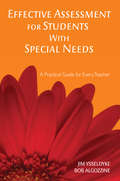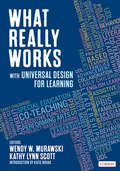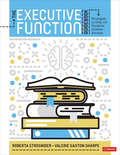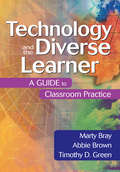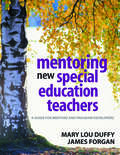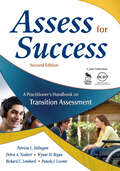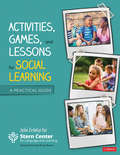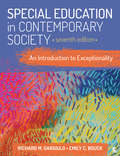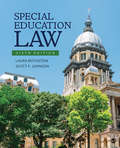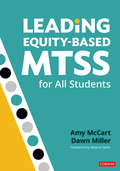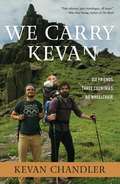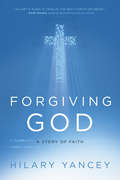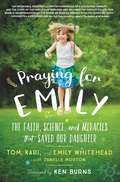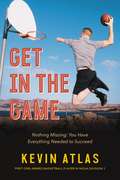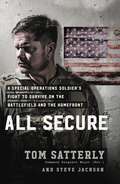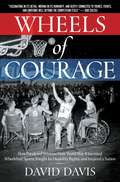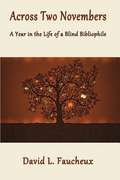- Table View
- List View
Effective Assessment for Students With Special Needs: A Practical Guide for Every Teacher (Practical Approach To Special Education For Every Teacher Ser.)
by Bob Algozzine Dr James E. YsseldykeDiscover what assessment methods you should be using, and how, when, and where they should be administered to ensure appropriate services are selected for all exceptional students.
What Really Works With Universal Design for Learning
by Wendy Murawski Kathy Lynn ScottLearn how to REALLY improve outcomes for all students How do we remove learning barriers and provide all students with the opportunity to succeed? Written for both general and special educators from grades Pre-K through 12, What Really Works with Universal Design for Learning is the how-to guide for implementing aspects of Universal Design Learning (UDL) to help every student be successful. UDL is the design and delivery of curriculum and instruction to meet the needs of all learners by providing them with choices for what and why they are learning and how they will share what they have learned. Calling on a wide-range of expertise, this resource features An unprecedented breadth of topics, including content areas, pedagogical issues, and other critical topics like executive function, PBIS, and EBD Reproducible research-based, field-tested tools Practical strategies that are low cost, time efficient, and easy to implement Practices for developing shared leadership and for working with families
What Really Works With Universal Design for Learning
by Wendy Murawski Kathy Lynn ScottLearn how to REALLY improve outcomes for all students How do we remove learning barriers and provide all students with the opportunity to succeed? Written for both general and special educators from grades Pre-K through 12, What Really Works with Universal Design for Learning is the how-to guide for implementing aspects of Universal Design Learning (UDL) to help every student be successful. UDL is the design and delivery of curriculum and instruction to meet the needs of all learners by providing them with choices for what and why they are learning and how they will share what they have learned. Calling on a wide-range of expertise, this resource features An unprecedented breadth of topics, including content areas, pedagogical issues, and other critical topics like executive function, PBIS, and EBD Reproducible research-based, field-tested tools Practical strategies that are low cost, time efficient, and easy to implement Practices for developing shared leadership and for working with families
The Executive Function Guidebook: Strategies to Help All Students Achieve Success
by Roberta I. Strosnider Valerie Saxton SharpeTeach some of the most important skills your students will ever need! Executive function skills—including self-regulation, focus, planning, and time-management—are essential to student success, but they must be taught and practiced. This unique guidebook provides a flexible seven-step model, incorporating UDL principles and the use of metacognition, for making executive-function training part of your classroom routine at any grade level. Features include: Descriptions of each skill and its impact on learning Examples of instructional steps to assist students as they set goals and work to achieve success. Strategies coded by competency and age/grade level Authentic snapshots and “think about” sections Templates for personalized goal-setting, data collection, and success plans Accompanying strategy cards
The Executive Function Guidebook: Strategies to Help All Students Achieve Success
by Roberta I. Strosnider Valerie Saxton SharpeTeach some of the most important skills your students will ever need! Executive function skills—including self-regulation, focus, planning, and time-management—are essential to student success, but they must be taught and practiced. This unique guidebook provides a flexible seven-step model, incorporating UDL principles and the use of metacognition, for making executive-function training part of your classroom routine at any grade level. Features include: Descriptions of each skill and its impact on learning Examples of instructional steps to assist students as they set goals and work to achieve success. Strategies coded by competency and age/grade level Authentic snapshots and “think about” sections Templates for personalized goal-setting, data collection, and success plans Accompanying strategy cards
Technology and the Diverse Learner: A Guide to Classroom Practice
by Marty Bray Professor Abbie Brown Dr Timothy Tim GreenSpecifically designed for the K-12 inclusive classroom, this timely handbook demonstrates how to easily and effectively capitalize on available technology.
Mentoring New Special Education Teachers: A Guide for Mentors and Program Developers (1-off Ser.)
by Mary Lou Duffy Dr James W. ForganHow do you avoid the high cost of turnover and retain high-quality special education teachers in such a demanding field? Special education teachers are leaving the field at twice the rate of general education teachers. Why? Mentoring New Special Education Teachers will help administrators and other educators develop and sustain effective mentoring programs specifically designed for special education teachers, providing practical, field-tested activities and resources for both the mentors and the mentees, including such critical elements as: Effectively identifying, recruiting, and selecting mentors Action planning Evaluating progress Addressing diminishing support Dealing with burnout and isolation Vignettes of real-life mentoring experiences Figures, tables, appendices, and Web sites A ready-to-use two-day workshop for training mentors
Assess for Success: A Practitioner′s Handbook on Transition Assessment
by Sitlington, Patricia L., Neubert, Debra A., Begun, Wynne H., Lombard, Richard C. and Leconte, Pamela J."Makes a distinct contribution to the field, addressing a critical area of responsibility for schools under IDEA 2004."—Gary Clark, Professor of Special EducationUniversity of Kansas"Will become a valuable resource to many stakeholders."—Jeanne Repetto, Professor of Special EducationUniversity of FloridaHelp students with disabilities transition successfully into adult life!Assisting students with disabilities in planning for their future as adults offers both challenges and unique opportunities for educators. An authoritative guidebook for Individualized Education Program (IEP) and Individualized Transition Planning teams, Assess for Success, Second Edition, helps students, special educators, and families define appropriate goals—including postsecondary education and employment choices—for the transition to adult life. New resources in the revised edition emphasize practical transition assessment techniques with sample forms for community assessment, job analysis, and vocational training analysis. Written by a team of highly respected authors, and aligned with the reauthorization of IDEA 2004, the text discusses self-determination and career development, and demonstrates how to:Utilize methods for transition assessmentUse assessment outcomes in IEP developmentCollaborate effectively with team members and other participantsMatch students to appropriate transition environmentsStudents with disabilities can successfully transition into adult life when they are supported by solid planning, realistic goals, and a team of caring individuals who want to ensure the best possible outcome.
Mentoring New Special Education Teachers: A Guide for Mentors and Program Developers (1-off Ser.)
by Mary Lou Duffy Dr James W. ForganHow do you avoid the high cost of turnover and retain high-quality special education teachers in such a demanding field? Special education teachers are leaving the field at twice the rate of general education teachers. Why? Mentoring New Special Education Teachers will help administrators and other educators develop and sustain effective mentoring programs specifically designed for special education teachers, providing practical, field-tested activities and resources for both the mentors and the mentees, including such critical elements as: Effectively identifying, recruiting, and selecting mentors Action planning Evaluating progress Addressing diminishing support Dealing with burnout and isolation Vignettes of real-life mentoring experiences Figures, tables, appendices, and Web sites A ready-to-use two-day workshop for training mentors
Activities, Games, and Lessons for Social Learning: A Practical Guide
by Stern Center for Language and LearningIn these games, the prize is success in school—and life. Having good social skills doesn’t just affect classroom behavior—it’s the key to making learning stick. When students improve their self-regulation, social communication, and perspective-taking competencies, they are better prepared to challenge themselves academically, take on tough tasks, and collaborate with teachers and classmates to achieve real, lasting school success. And since these skills also improve life outside school, the benefits come full circle. Designed for both explicit instruction and "learning by doing," this practical guide provides hands-on activities that are easily adapted into any curriculum and can be used in general education, special education, after-school settings, and in the home. The design of each game keeps kids engaged and motivated, while educators benefit from clear, thorough explanations that unpack the complexities of social learning. Other behind-the-scenes features include: Evidence-based, teacher-tested lessons Anecdotes and real-world examples Links to relevant research Expansion ideas for applying learned skills to broader situations Templates and reproducibles for easy implementation This curated collection of activities puts social-learning theory into practice, helping even the most challenging children develop the social skills necessary for real success in school—and beyond.
Activities, Games, and Lessons for Social Learning: A Practical Guide
by Stern Center for Language and LearningIn these games, the prize is success in school—and life. Having good social skills doesn’t just affect classroom behavior—it’s the key to making learning stick. When students improve their self-regulation, social communication, and perspective-taking competencies, they are better prepared to challenge themselves academically, take on tough tasks, and collaborate with teachers and classmates to achieve real, lasting school success. And since these skills also improve life outside school, the benefits come full circle. Designed for both explicit instruction and "learning by doing," this practical guide provides hands-on activities that are easily adapted into any curriculum and can be used in general education, special education, after-school settings, and in the home. The design of each game keeps kids engaged and motivated, while educators benefit from clear, thorough explanations that unpack the complexities of social learning. Other behind-the-scenes features include: Evidence-based, teacher-tested lessons Anecdotes and real-world examples Links to relevant research Expansion ideas for applying learned skills to broader situations Templates and reproducibles for easy implementation This curated collection of activities puts social-learning theory into practice, helping even the most challenging children develop the social skills necessary for real success in school—and beyond.
Special Education in Contemporary Society: An Introduction to Exceptionality
by Richard M. Gargiulo Emily C. BouckSpecial Education in Contemporary Society: An Introduction to Exceptionality, Seventh Edition offers a comprehensive, engaging, and readable introduction to the dynamic field of special education. Grounded in research and updated to reflect the most current thinking and standards of the field, this book provides readers with the knowledge, skills, attitudes, and beliefs that are crucial to constructing learning environments that allow all students to reach their full potential. Authors Richard M. Gargiulo and Emily C. Bouck encourage a deep awareness and understanding of the &“human&” side of special education, providing readers with a look into the lives of exceptional students and their families, as well as the teachers that work with exceptional persons throughout their lives.
Special Education in Contemporary Society: An Introduction to Exceptionality
by Richard M. Gargiulo Emily C. BouckSpecial Education in Contemporary Society: An Introduction to Exceptionality, Seventh Edition offers a comprehensive, engaging, and readable introduction to the dynamic field of special education. Grounded in research and updated to reflect the most current thinking and standards of the field, this book provides readers with the knowledge, skills, attitudes, and beliefs that are crucial to constructing learning environments that allow all students to reach their full potential. Authors Richard M. Gargiulo and Emily C. Bouck encourage a deep awareness and understanding of the &“human&” side of special education, providing readers with a look into the lives of exceptional students and their families, as well as the teachers that work with exceptional persons throughout their lives.
Special Education Law: Rothstein, Special Education Law, Fourth Edition + Osborne, Special Education And The Law: A Guide For Practitioners, Second Edition
by Scott F. Johnson Professor Laura F. RothsteinSpecial Education Law 6e, written by Laura Rothstein and Scott F. Johnson, provides a comprehensive and current overview of the major federal law, and judicial interpretations of those laws, that apply to special education students. School administrators and attorneys attend to special education issues on a regular basis, and local superintendents, principals, special education professionals, psychologists, and regional and state administrators must also be familiar with the legal requirements of educating students with disabilities. Classroom teachers in all types of classrooms need to be aware of the laws that affect them and their students. Special Education Law 6e is intended for students in education and educational administration, both graduate and undergraduate, as well as law students in courses on special education law, school law, and special education. The framework of this book begins with five introductory chapters on the major issues that are addressed in special education law. These topics include an overview the legal system, the history of special education, major statutes in special education law, stakeholders such as students, families, educators, and advocates, and finally, requirements for protection under various special education laws. The remainder of the text presents and analyzes special education case law within specific contexts. The text helps educators understand what the law requires so that they can make decisions that comply with these laws. Updates for the sixth edition include a major reorganization of the text. Chapters have been streamlined and edited for clarity, combining a previous chapter on Related Services with Free Appropriate Publication Education, and folding Eligibility into Identification, Evaluation, and Eligibility, so students can better see the connections between these topics. Many case excerpts have been shortened or summarized to provide students with a more straightforward and focused reading experience. The latest updates in statutes, regulations, and case law are included throughout the text.
Special Education Law: Rothstein, Special Education Law, Fourth Edition + Osborne, Special Education And The Law: A Guide For Practitioners, Second Edition
by Scott F. Johnson Professor Laura F. RothsteinSpecial Education Law 6e, written by Laura Rothstein and Scott F. Johnson, provides a comprehensive and current overview of the major federal law, and judicial interpretations of those laws, that apply to special education students. School administrators and attorneys attend to special education issues on a regular basis, and local superintendents, principals, special education professionals, psychologists, and regional and state administrators must also be familiar with the legal requirements of educating students with disabilities. Classroom teachers in all types of classrooms need to be aware of the laws that affect them and their students. Special Education Law 6e is intended for students in education and educational administration, both graduate and undergraduate, as well as law students in courses on special education law, school law, and special education. The framework of this book begins with five introductory chapters on the major issues that are addressed in special education law. These topics include an overview the legal system, the history of special education, major statutes in special education law, stakeholders such as students, families, educators, and advocates, and finally, requirements for protection under various special education laws. The remainder of the text presents and analyzes special education case law within specific contexts. The text helps educators understand what the law requires so that they can make decisions that comply with these laws. Updates for the sixth edition include a major reorganization of the text. Chapters have been streamlined and edited for clarity, combining a previous chapter on Related Services with Free Appropriate Publication Education, and folding Eligibility into Identification, Evaluation, and Eligibility, so students can better see the connections between these topics. Many case excerpts have been shortened or summarized to provide students with a more straightforward and focused reading experience. The latest updates in statutes, regulations, and case law are included throughout the text.
Leading Equity-Based MTSS for All Students
by Amy McCart Dr. Dawn Dee MillerEnsure that Every Child Achieves Academic and Social Success An equity-based multi-tiered system of support (MTSS) helps school teams engage all students across the full range of learning needs. MTSS ensures that the vision of equity for every student is achieved, with high expectations and quality instruction, while not straining a school&’s budget or personnel. This strategy filled book teaches you how to • Engage all students in learning through an equity-based approach • Analyze and utilize your resources • Apply strengths- and evidence-based principles for implementation • Incorporate effective tools to systematize MTSS
Leading Equity-Based MTSS for All Students
by Amy McCart Dr. Dawn Dee MillerEnsure that Every Child Achieves Academic and Social Success An equity-based multi-tiered system of support (MTSS) helps school teams engage all students across the full range of learning needs. MTSS ensures that the vision of equity for every student is achieved, with high expectations and quality instruction, while not straining a school&’s budget or personnel. This strategy filled book teaches you how to • Engage all students in learning through an equity-based approach • Analyze and utilize your resources • Apply strengths- and evidence-based principles for implementation • Incorporate effective tools to systematize MTSS
Butterflies and Second Chances: A Mom's Memoir of Love and Loss
by Annette HinesThe author recounts her struggles and joys as the single mother of two daughters, one of whom has severe multiple disabilities. Born with a mitochondrial disease that causes blindness, seizures, and impairments in speech as well as motor and intellectual development, Elizabeth requires many hospitalizations and intensive full-time care when she is at home. The author writes about her struggles to obtain the help she needs and how, through her life with Elizabeth, she builds a career as a disability lawyer. She writes frankly about dealing with her grief after Elizabeth's death.
We Carry Kevan: Six Friends. Three Countries. No Wheelchair.
by Kevan ChandlerKevan is just one of the guys. It's impossible to know him and not become a little more excited about life. He is an inspiring man permeated by joy, unafraid of sorrow, full of vitality and life! His sense of humor is infectious and so is his story.He grew up, he says, at "belt-buckle level" and stayed there until Kevan's beloved posse decided to leave his wheelchair at the Atlanta airport, board a plane for France, and have his friends carry him around Europe to accomplish their dream to see the world together! Kevan's beloved posse traveled to Paris, England, and Ireland where, in the climax of their adventure, they scale 600 feet up to the 1,400-year-old monastic fortress of Skellig Michael.In WE CARRY KEVAN the reader sits with Kevan, one head-level above everyone else for the first time in his life and enjoys camaraderie unlike anything most people ever experience. Along the way they encounter the curiosity and beauty of strangers, the human family disarmed by grace, and the constant love of God so rich and beautiful in the company of good friends. WE CARRY KEVAN displays the profound power of friendship and self-sacrifice.
Forgiving God: A Story of Faith
by Hilary YanceyA young mother's life is forever changed and her faith in God is broken when her son in diagnosed with complex physical disabilities. Restore and grow your faith as you read about Hilary Yancey's personal journey back to God. Three months into her pregnancy with her first child, Hilary Yancey received a phone call that changed everything. As she learned the diagnosis-cleft lip and palate, a missing right eye, possible breathing complications-Hilary began to pray in earnest. Even in the midst of these findings, she prayed that God would heal her son. God could do a miracle unlike anything she had seen. Only when Hilary held her baby, Jack, in her arms for the first time did she realize God had given her something drastically different than what she had demanded. Hilary struggled to talk to God as she sat for six weeks beside Jack's crib in the NICU. She consented to surgeries and learned to care for a breathing tube and gastronomy button. In her experience with motherhood Hilary had become more familiar with the sound of her son's heart monitor than the sound of his heartbeat. Later, during surgeries and emergency trips back to the hospital with her crying, breathless boy, Hilary reproached the stranger God had become. Jack was different. Hilary was not the mother she once imagined. God was not who Hilary knew before. But she could not let go of one certainty-she could see the image of Christ in Jack's face. Slowly, through long nights of wrestling and longer nights of silence, Hilary cut a path through her old, familiar faith to the God behind it. She discovered that it is by walking out onto the water, where the firm ground gives way, that we can find him. And meeting Jesus, who rises with his scars to proclaim new life, is never what you once imagined.
Praying for Emily: The Faith, Science, and Miracles that Saved Our Daughter
by Tom Whitehead Kari Whitehead Emily WhiteheadDiscover the incredible true story of Emily Whitehead, the first child to receive CAR-T cell treatment for her leukemia -- and learn how her family's faith journey guided them in the fight for her life.When their five-year-old daughter was diagnosed with leukemia, Tom and Kari Whitehead's world was shattered. They vowed to do whatever it took to help their daughter, and as they made decisions about how to best treat her, Tom found his faith coming to him in "whispers," guiding his decisions and keeping his hope alive, while Kari placed great faith in science and the doctors surrounding her little girl. But as Emily's condition continued to worsen, they both prayed for a miracle.Then, their miracle arrived, in the form of an experimental treatment called CAR-T cell therapy that, against all odds, saved Emily's life. Because of Emily's miraculous recovery, this treatment is now used widely to treat cancer and has gone on to save hundreds of lives and promises to help thousands more. For all the acclaim and attention this important new approach to treating cancer has received, few know the full story of all it took to make this miracle happen.In Praying for Emily, the Whiteheads share their story, recounting the belief, resilience, and support that got them through the most difficult time of their lives.
Get in the Game: Nothing Missing: You Have Everything Needed to Succeed
by Kevin AtlasBe inspired by the story of Kevin Atlas (formerly Laue), whose faith and perseverance helped him become an NCAA Division I basketball player, despite being born with only one arm.Even before entering the world, Kevin Atlas was a fighter. He should have died in childbirth, as the umbilical cord was wrapped around his neck twice, but he survived because his left arm was in the middle of it, allowing blood to flow to his brain. But since circulation was cut off in that arm, he was born with his left arm ending just below his elbow. GET IN THE GAME is Kevin's story of transformation: Moving from anger to joy. From embarrassment to confidence. From the sidelines and wishing his life was different to getting in the game and showing who he is. Kevin's arduous journey to earning a scholarship to Manhattan College in New York City and becoming the first NCAA Division I basketball player missing a limb has given him keen insights to help anyone who feels trapped and defeated by less-than-perfect circumstances, whether physical, mental, or environmental. Kevin doesn't encourage readers to simply accept and live with their challenges, hurts, and losses. He spurs them on to believe any weakness can, in reality, become the one thing that propels them to achieve their greatest potential. As Kevin has learned throughout his life, you can't win if you don't get in the game!
All Secure: A Special Operations Soldier's Fight to Survive on the Battlefield and the Homefront
by Steve Jackson Tom SatterlyOne of the most highly regarded Tier One Delta Force operators in American military history shares his war stories and personal battle with PTSD.As a senior non-commissioned officer of Delta Force, the most elite and secretive special operations unit in the U.S. military, Command Sergeant Major Tom Satterly fought some of this country's most fearsome enemies. Over the course of twenty years and thousands of missions, he's fought desperately for his life, rescued hostages, killed and captured terrorist leaders, and seen his friends maimed and killed around him. All Secure is in part Tom's journey into a world so dark and dangerous that most Americans can't contemplate its existence. It recounts what it is like to be on the front lines with one of America's most highly trained warriors. As action-packed as any fiction thriller, All Secure is an insider's view of "The Unit." Tom is a legend even among other Tier One special operators. Yet the enemy that cost him three marriages, and ruined his health physically and psychologically, existed in his brain. It nearly led him to kill himself in 2014; but for the lifeline thrown to him by an extraordinary woman it might have ended there. Instead, they took on Satterly's most important mission-saving the lives of his brothers and sisters in arms who are killing themselves at a rate of more than twenty a day. Told through Satterly's firsthand experiences, it also weaves in the reasons-the bloodshed, the deaths, the intense moments of sheer terror, the survivor's guilt, depression, and substance abuse-for his career-long battle against the most insidious enemy of all: Post Traumatic Stress. With the help of his wife, he learned that by admitting his weaknesses and faults he sets an example for other combat veterans struggling to come home.
Wheels of Courage: How Paralyzed Veterans from World War II Invented Wheelchair Sports, Fought for Disability Rights, and Inspired a Nation
by David DavisOut of the carnage of World War II comes an unforgettable tale about defying the odds and finding hope in the most harrowing of circumstances. Wheels of Courage tells the stirring story of the soldiers, sailors, and marines who were paralyzed on the battlefield during World War II-at the Battle of the Bulge, on the island of Okinawa, inside Japanese POW camps-only to return to a world unused to dealing with their traumatic injuries. Doctors considered paraplegics to be "dead-enders" and "no-hopers," with the life expectancy of about a year. Societal stigma was so ingrained that playing sports was considered out-of-bounds for so-called "crippled bodies." But servicemen like Johnny Winterholler, a standout athlete from Wyoming before he was captured on Corregidor, and Stan Den Adel, shot in the back just days before the peace treaty ending the war was signed, refused to waste away in their hospital beds. Thanks to medical advances and the dedication of innovative physicians and rehabilitation coaches, they asserted their right to a life without limitations. The paralyzed veterans formed the first wheelchair basketball teams, and soon the Rolling Devils, the Flying Wheels, and the Gizz Kids were barnstorming the nation and filling arenas with cheering, incredulous fans. The wounded-warriors-turned-playmakers were joined by their British counterparts, led by the indomitable Dr. Ludwig Guttmann. Together, they triggered the birth of the Paralympic Games and opened the gymnasium doors to those with other disabilities, including survivors of the polio epidemic in the 1950s. Much as Jackie Robinson's breakthrough into the major leagues served as an opening salvo in the civil rights movement, these athletes helped jump-start a global movement about human adaptability. Their unlikely heroics on the court showed the world that it is ability, not disability, that matters most. Off the court, their push for equal rights led to dramatic changes in how civilized societies treat individuals with disabilities: from kneeling buses and curb cutouts to the Americans with Disabilities Act of 1990. Their saga is yet another lasting legacy of the Greatest Generation, one that has been long overlooked. Drawing on the veterans' own words, stories, and memories about this pioneering era, David Davis has crafted a narrative of survival, resilience, and triumph for sports fans and athletes, history buffs and military veterans, and people with and without disabilities.
Across Two Novembers: A Year in the Life of a Blind Bibliophile
by David Faucheux<P>Friends and family. Restaurants and recipes. Hobbies and history. TV programs the author loved when he could still see and music he enjoys. The schools he attended and the two degrees he attained. The career that eluded him and the physical problems that challenge him. And books, books, books: over 230 of them quoted from or reviewed. All in all, an astonishing work of erudition and remembrance.
